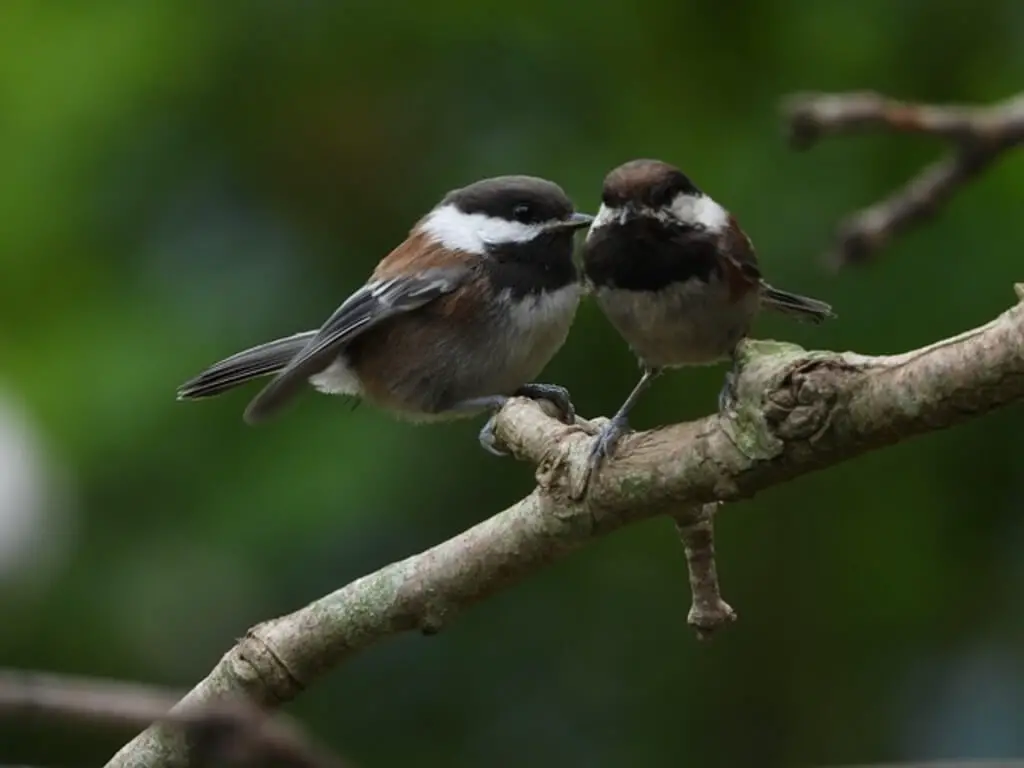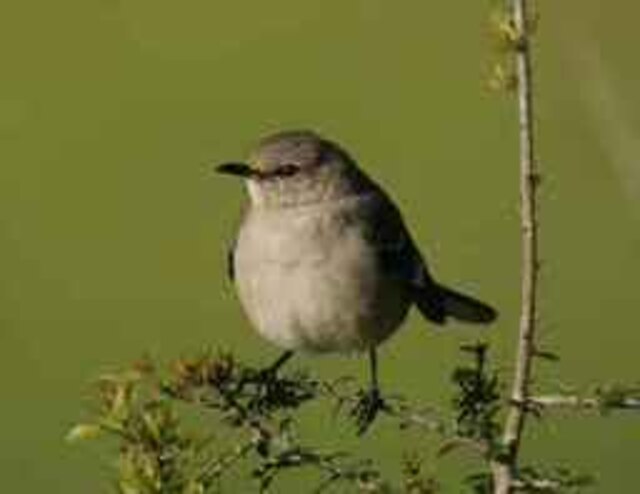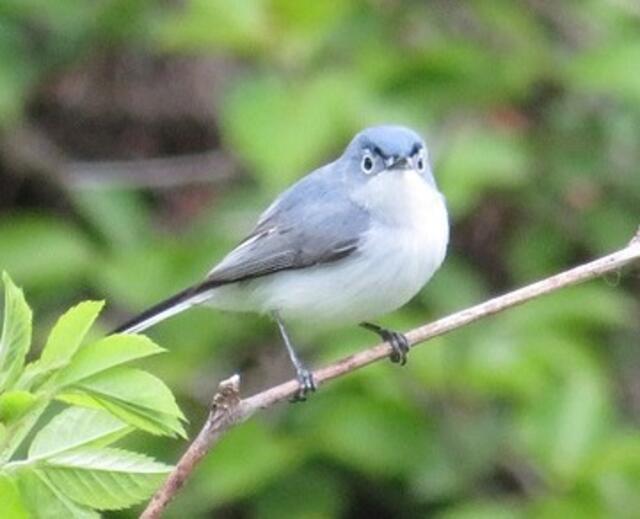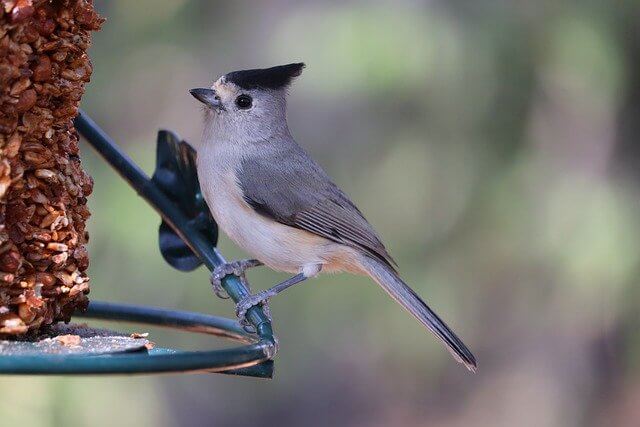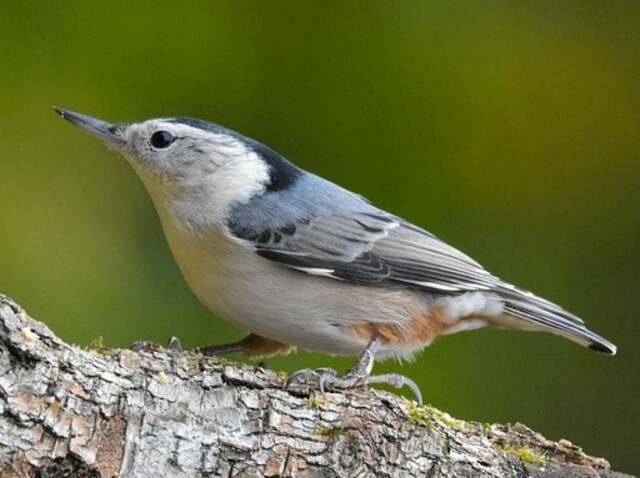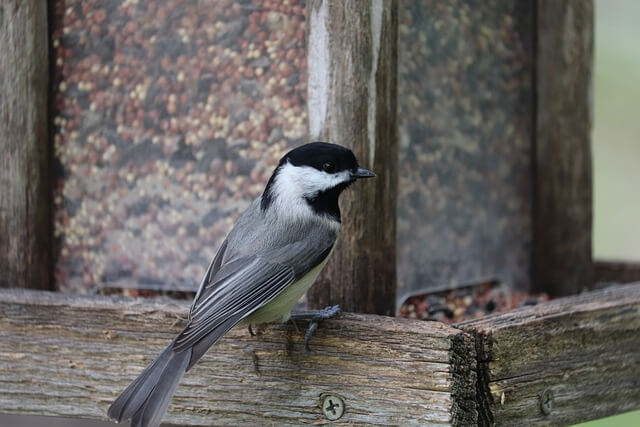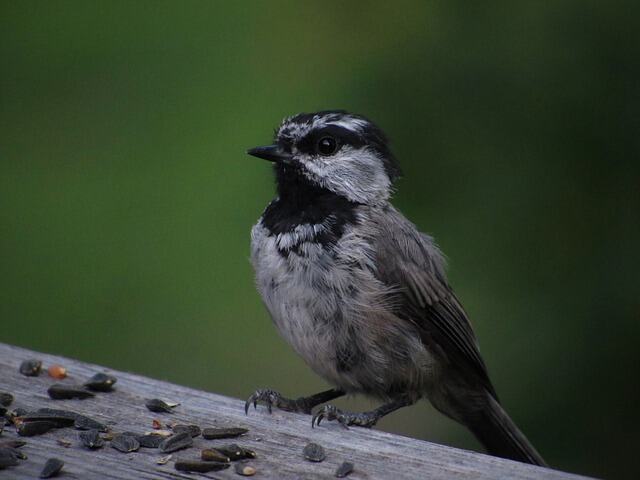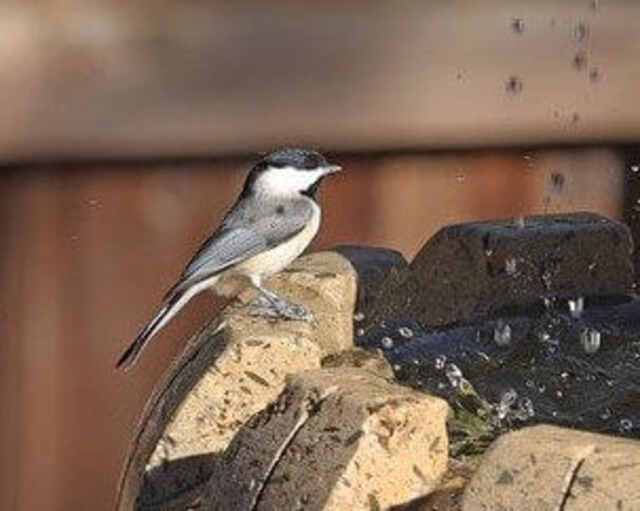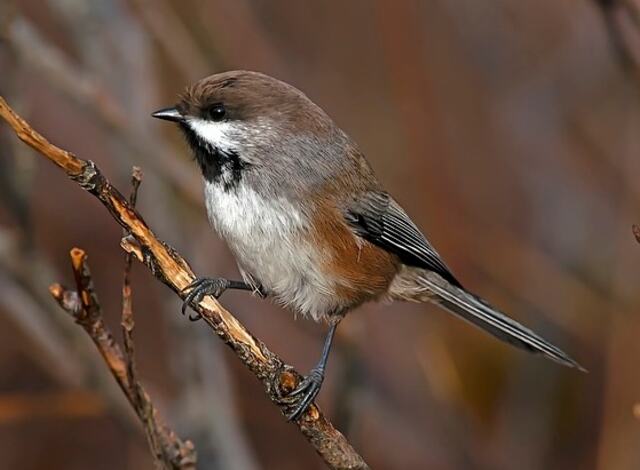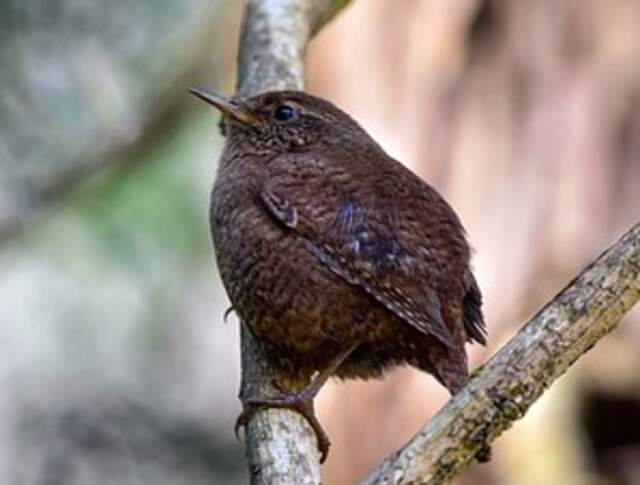Chickadees are small, sprightly birds that are a familiar sight at backyard bird feeders across North America. But did you know that there are different species of birds that look like chickadees?
In this complete guide, we’ll take a look at all 16 species, with photos and ID tips to help you tell them apart. We’ll also include maps showing where they’re found, plus recordings of their songs and calls.
Table of Contents
- 1 Birds That Look Like Chickadees
- 1.1 Black-tailed Gnatcatcher
- 1.2 Blue-gray Gnatcatcher
- 1.3 American Tree Sparrow
- 1.4 Black-throated sparrow
- 1.5 Tufted Titmouse
- 1.6 White-breasted Nuthatch
- 1.7 Blackpoll Warbler
- 1.8 Chestnut-backed Chickadee
- 1.9 Carolina Chickadee
- 1.10 Black-capped Chickadee
- 1.11 Mountain Chickadee
- 1.12 Gray-headed Chickadee
- 1.13 Boreal Chickadee
- 1.14 Bushtit
- 1.15 Carolina Wren
- 1.16 Winter Wren
- 2 Author
Birds That Look Like Chickadees
Black-tailed Gnatcatcher
- Length: 4.3-5.1 in (11-13 cm)
- Weight: 0.2-0.2 oz (5.1-6 g)
- Wingspan: 5.5-5.9 in (14-15 cm)
The Black-tailed Gnatcatcher is a small bird found in arid regions of southwestern United States and Mexico. It has a distinctive black tail and a grayish-blue body. These birds inhabit desert scrub, mesquite groves, and thorn-scrub areas.
Their diet primarily consists of insects, including ants, caterpillars, and beetles. They are highly active and agile, often seen flitting from branch to branch in search of food. Black-tailed Gnatcatchers are known for their vocalizations, which include high-pitched calls and soft trills.
In contrast, the Chickadee is a small bird found throughout North America. They inhabit a variety of forested habitats, including deciduous and coniferous forests, as well as suburban areas. Their diet is dominated by insects, seeds, and berries.
They are known for their distinctive black cap and bib, as well as their acrobatic abilities. Chickadees are highly social and often form flocks during the winter months. They are also known for their characteristic chick-a-dee-dee-dee call.
Blue-gray Gnatcatcher
- Length: 3.9-4.3 in (10-11 cm)
- Weight: 0.2-0.3 oz (4.8-8.9 g)
- Wingspan: 6.3 in (16 cm)
The Blue-gray Gnatcatcher (Polioptila caerulea) is a small, active, insect-eating bird found throughout most of North America. The bird’s plumage is mostly gray, with a blue-gray head and a long, narrow tail. They are about 4.5 inches long and weigh about 0.2 ounces.
Blue-gray Gnatcatchers inhabit dense, deciduous forests, but also thrive in urban parks and gardens. Their diet consists primarily of insects and spiders, which they capture by darting and hovering among the leaves and branches of trees.
The Chickadee, on the other hand, is a small, social bird that belongs to the Paridae family. They are found throughout North America, with various species inhabiting different regions. The most common Chickadee species in North America is the Black-capped Chickadee (Poecile atricapillus).
Chickadees are similar to Blue-gray Gnatcatchers in size and weight, but their plumage is different – Chickadees are primarily black and white, with distinctive black caps on their heads.
They also have a slightly different diet, feeding on insects, seeds, and berries. Chickadees inhabit forests and woodland edges, but can also be found in suburban areas and parks.
American Tree Sparrow
- Length: 5.5 in (14 cm)
- Weight: 0.5-1.0 oz (13-28 g)
- Wingspan: 9.4 in (24 cm)
The Tree Sparrow, Passer montanus, is a small passerine bird that measures approximately 11–13 cm in length and weighs about 24 g. The male and female Tree Sparrow have similar plumage, with a chestnut-brown crown and nape, a grayish-black bib, and a chestnut-brown mantle.
The Tree Sparrow has a widespread distribution throughout Europe and Asia, with a preference for open habitats such as farmland, hedgerows, and gardens. Their diet consists of mainly seeds and insects, including wheat, barley, and oats. During the breeding season, they feed their young with insects.
The Chickadee, Poecile atricapillus, is a small bird of the tit family that measures approximately 11–14 cm in length and weighs about 9-14g. The Chickadee has a distinctive black cap and bib with white cheeks, while their back is a grayish-brown.
The Chickadee has a widespread distribution throughout North America, with a preference for mixed forests and deciduous woodlands. Their diet consists of mainly insects, seeds, and berries, including sunflower seeds and peanuts.
Chickadees are known for their curious and social behavior and will readily visit backyard bird feeders.
Read more: 10 Fascinating American Tree Sparrow Facts
Black-throated sparrow
- Length: 4.7-5.5 in (12-14 cm)
- Weight: 0.4-0.5 oz. (11-15 g)
- Wingspan: 7.7 in (19.5 cm)
The Black-throated Sparrow is a small, desert-dwelling bird found throughout the southwestern United States and Mexico. It is easily recognized by its distinctive black throat patch and contrasting white eyeline. This species prefers open, arid habitats such as sagebrush flats and rocky canyons, where it feeds on a variety of seeds and insects.
The Black-throated Sparrow is known for its melodious song, which is a series of clear, descending notes that can be heard throughout the day. Despite its small size, this bird is well adapted to life in the harsh desert environment.
The Chickadee, on the other hand, is a small, active bird found across much of North America. Like the Black-throated Sparrow, it is a seed and insect eater and has a distinct vocalization – the “chick-a-dee-dee-dee” call for which it is named.
However, the Chickadee is primarily a forest bird, inhabiting wooded areas throughout its range. It is easily recognized by its gray and white plumage, black cap, and distinctive white eyebrow. While the Chickadee is similar in size to the Black-throated Sparrow, its behavior and habitat preferences are quite different.
Read more: How to Attract Sparrows to your Backyard? (Like A Pro)
Tufted Titmouse
- Length: 5.5-6.3 in (14-16 cm)
- Weight: 0.6-0.9 oz (18-26 g)
- Wingspan: 7.9-10.2 in (20-26 cm)
The Tufted Titmouse (Baeolophus bicolor) is a small songbird that can be easily identified by its distinctive tuft of feathers on its head. They are found in eastern North America, ranging from the southern parts of Canada to the Gulf of Mexico.
These birds prefer deciduous forests and woodland edges as their habitat and are known to have a varied diet that includes insects, seeds, berries, and nuts. They are a common sight at bird feeders, where they will readily eat sunflower seeds and suet.
The Tufted Titmouse and the Chickadee are both members of the Paridae family and share many similarities. They have similar ranges, habitats, and diets, with the Chickadee found in the same geographic areas as the Titmouse.
However, the Chickadee is smaller than the Titmouse and lacks the tuft of feathers on its head. Chickadees are also known for their distinct vocalizations, while the Titmouse has a more monotone call.
Additionally, the Chickadee is known to be more acrobatic, often hanging upside down to feed, while the Titmouse prefers to perch upright.
Despite these differences, both birds share a common love for seeds, nuts, insects, and berries, making them a popular sight at backyard bird feeders.
Read more: How to Attract Tufted Titmouse to my Yard? (Explained)
White-breasted Nuthatch
- Length: 5.1-5.5 in (13-14 cm)
- Weight: 0.6-1.1 oz (18-30 g)
- Wingspan: 7.9-10.6 in (20-27 cm)
The White-breasted Nuthatch is a small passerine bird that can be found in North America. It has a distinctive black cap and a white face with a blue-gray back and wings. This bird is known for its unique habit of walking headfirst down tree trunks and branches, as well as its ability to store seeds in crevices and bark for later consumption.
The White-breasted Nuthatch can be found in deciduous forests, woodlands, and suburban areas across much of the United States and southern Canada. Its diet consists of insects, nuts, and seeds. The Chickadee, on the other hand, is also a small passerine bird that can be found in North America.
Similar to the White-breasted Nuthatch, it has a distinctive black cap, but its body is gray and white with a black bib. Chickadees can be found in a variety of habitats, including deciduous and coniferous forests, as well as suburban areas.
Their diet consists of insects, seeds, and berries. While both birds are similar in size and diet, the Chickadee is more social and often travels in flocks, while the White-breasted Nuthatch is generally solitary.
Additionally, the Chickadee has a more varied vocal repertoire and is known for its distinctive “chick-a-dee-dee-dee” call, while the White-breasted Nuthatch has a nasal “yank-yank” call.
Read more: How to Attract Nuthatches to your Backyard? Expert Tips!
Blackpoll Warbler
- Length: 5.5 in (14 cm)
- Weight: 0.4-0.5 oz (12-13 g)
- Wingspan: 8.3-9.1 in (21-23 cm)
The Blackpoll Warbler (Setophaga striata) is a small migratory songbird with a striking black and white plumage, streaked flanks, and a black cap. They breed in the boreal forests of Canada and Alaska and migrate to the eastern United States and the Caribbean for the winter. They prefer to forage high up in the canopy, feeding mainly on insects and spiders.
Interestingly, during migration, they undertake one of the longest non-stop overwater flights by any songbird, flying for up to 88 hours straight to reach their wintering grounds in South America. In contrast, the Chickadee (Poecile) is a small passerine bird with a distinctive black cap and bib, white cheeks, and grayish-brown back and wings.
They are resident year-round in most of North America, including Canada and the United States, and can be found in a wide range of habitats, from deciduous and coniferous forests to parks and suburban areas. Chickadees are omnivores, feeding on insects, seeds, and berries, and are known for their ability to store food for the winter.
They are also social birds, forming flocks during the non-breeding season and communicating with a variety of calls and vocalizations.
Read more: How to Attract Warblers to your Yard? (Expert Tips)
Chestnut-backed Chickadee
- Length: 3.9-4.7 in (10-12 cm)
- Weight: 0.3-0.4 oz (7-12 g)
- Wingspan: 7.5 in (19 cm)
The Chestnut-backed Chickadee (Poecile rufescens) is a small passerine bird found in western North America. With a distinctive chestnut-colored back and wings, it is easily recognizable. They are commonly found in coniferous forests, preferring areas with dense undergrowth and a variety of tree species. Their diet consists of insects, spiders, and seeds, and they are known to cache food in trees for later consumption.
Their vocalizations include a distinctive high-pitched “see-see-see” call. In comparison to other chickadee species, the Chestnut-backed Chickadee has a smaller range, primarily found in western North America from Alaska to northern California.
They also have a preference for coastal habitats, compared to other chickadee species, which are found in a variety of habitats. Additionally, they are slightly smaller in size with a shorter tail and a shorter, thicker bill.
Despite these differences, they share similar diets and habits, with a preference for insects and seeds and a habit of caching food. They also have similar vocalizations, including the distinctive “chick-a-dee-dee-dee” call commonly associated with chickadees.
Carolina Chickadee
- Length: 3.9-4.7 in (10-12 cm)
- Weight: 0.3-0.4 oz (8-12 g)
- Wingspan: 5.9-7.9 in (15-20 cm)
The Carolina Chickadee, also known as the Black-capped Chickadee, is a small bird species found in the southeastern region of the United States. These birds have distinctive black caps and bibs, white cheeks, and grayish-brown backs. They measure approximately 4 to 5 inches in length and weigh about 0.3 to 0.4 ounces.
Carolina Chickadees prefer deciduous and mixed forests, as well as suburban areas with mature trees. Their diet is made up primarily of bugs, spiders, seeds, and fruit. These birds are known for their acrobatic foraging style, clinging to branches and twigs to find food.
In comparison to the Carolina Chickadee, the Black-capped Chickadee is found in northern and central parts of the United States and Canada. They are very similar in appearance, with black caps and bibs, white cheeks, and grayish-brown backs.
However, Black-capped Chickadees are slightly larger, measuring around 5 to 6 inches in length and weighing about 0.4 to 0.5 ounces. Their habitat preferences are also slightly different, as they can be found in boreal and mixed forests.
Their diet is similar to the Carolina Chickadee, consisting of insects, spiders, seeds, and berries. Both species are known for their social nature and ability to form flocks with other birds in the winter.
Read more: Carolina Chickadees – 9 Best Ways To Attract Them Fast!
Black-capped Chickadee
- Length: 4.7-5.9 in (12-15 cm)
- Weight: 0.3-0.5 oz (9-14 g)
- Wingspan: 6.3-8.3 in (16-21 cm)
The Black-capped Chickadee is a small passerine bird, measuring 11.5-14 cm in length and weighing 7-10 g. They are known for their distinctive black cap and bib, white cheeks, and gray back and wings. These birds are found across Canada and the northern United States, from Alaska to Maine. They prefer deciduous and mixed forests, as well as suburban areas with trees and shrubs.
Their diet consists of insects, seeds, and berries, and they are known for their ability to store food for later use. While similar in appearance, the Carolina Chickadee can be distinguished from the Black-capped Chickadee by its gray cap and back, and its shorter bib.
The Carolina Chickadee is found in the southeastern United States, from Virginia to Florida and west to Texas. It prefers deciduous and mixed forests, as well as suburban areas with trees and shrubs. Its diet consists of insects, seeds, and berries, and it is also known for its ability to store food for later use.
Despite these differences, both species share many characteristics, including their small size, social behavior, and cheerful vocalizations.
Read more: Unique Black-capped Chickadee Facts You Need To Know!
Mountain Chickadee
- Length: 5.0-6.0 in (13–15 cm)
- Weight: 11 gr.
- Wingspan: 7.5 in (19 cm)
The Mountain Chickadee is a small bird species that measures around 13 cm in length and weighs approximately 9–14 grams. These birds are primarily gray with a black cap and bib, and white cheeks. They have a distinctive call that sounds like “chick-a-dee-dee-dee.”
Mountain Chickadees can be found in the mountainous regions of western North America, from Alaska to Mexico. They prefer coniferous forests, where they can forage for insects and seeds. During winter, they store food in tree bark crevices and consume it later.
These birds are also known for their exceptional memory, enabling them to recall the location of thousands of food caches. The Chickadee and Mountain Chickadee share several characteristics such as their black cap and bib, white cheeks, and similar diet consisting of insects, seeds, and berries.
However, the Chickadee is found in a broader range of habitats, including deciduous forests, while the Mountain Chickadee is primarily found in coniferous forests. The Chickadee is slightly smaller than the Mountain Chickadee, measuring around 10-11 cm in length and weighing approximately 8–12 grams.
The Chickadee also has a more varied range of vocalizations and is known for its acrobatic behavior. Overall, both birds are highly intelligent and adaptable species that have captured the hearts of birdwatchers and enthusiasts worldwide.
Gray-headed Chickadee
- Length: 5.0-6.0 in (13–14 cm)
- Weight: 11–14.5 g
- Wingspan: 7.5 in (19 cm)
The Gray-headed Chickadee (Poecile cinctus) is a small passerine bird found in the boreal forests of North America and Asia. They have a distinctive gray cap and back, black bib, and white cheeks. They measure around 12 cm in length and have a wingspan of 17-19 cm.
They feed primarily on insects and seeds, and are known to cache food during the winter months. Their preferred habitat is in coniferous forests, especially those with spruce and fir trees. They are known for their acrobatic ability, often hanging upside down while foraging for food.
In comparison to the Chickadee, the Gray-headed Chickadee has a smaller range, primarily found in the boreal forests of North America and Asia. Their habitat preference is similar, as both species prefer coniferous forests.
The Gray-headed Chickadee is slightly larger than the Chickadee, measuring around 12 cm in length compared to the Chickadee’s 10 cm. While both species feed on insects and seeds, the Gray-headed Chickadee is known to cache food during the winter months.
The Chickadee is more commonly found in suburban areas and backyards, while the Gray-headed Chickadee is more elusive and typically only seen in their natural habitat.
Boreal Chickadee
- Length: 5.0-5.5 in (13–14 cm)
- Weight: 10 g
- Wingspan: 8.25 in (23.5 cm)
The Boreal Chickadee (Poecile hudsonica) is a small, non-migratory passerine bird found in the boreal forests of North America. They have a distinctive black cap, white cheeks, and grayish-brown back and wings. Unlike other chickadee species, they have a rust-colored patch on their flanks.
Boreal Chickadees primarily feed on insects and spiders during the summer months, but also consume seeds and berries during the winter. They nest in tree cavities and lay 6–8 eggs per clutch. While both Boreal and other chickadee species share similar physical characteristics and feeding habits, they differ in their range and habitat preferences.
Boreal Chickadees are found exclusively in boreal forests, while other species are more adaptable and can be found in a range of habitats. Additionally, Boreal Chickadees are slightly larger than other chickadee species, with a wingspan of up to 8 inches.
They also have a more muted coloration, with a grayish-brown back and wings rather than the black or brown of other species. Despite these differences, all chickadee species are known for their energetic and curious behavior, and their willingness to approach people.
Bushtit
- Length: 4.3 in (11 cm)
- Weight: 5.0-6.0 g (0.18–0.20 oz)
- Wingspan: 6.0 in (15.2 cm)
The Bushtit (Psaltriparus minimus) is a small, active, and social bird found in North America, from southern Canada to Central America. The Bushtit has a distinctive round body shape with a long tail and tiny, pointed bill.
They are grayish-brown in color, with a black eye mask and a light-colored belly. They typically live in deciduous woodlands, shrublands, and riparian habitats. Their diet primarily consists of insects, spiders, and small arthropods, which they glean from the foliage and bark of trees and shrubs.
In comparison, the Chickadee is another small bird found in North America, and is known for its striking black and white coloring. They also have a distinctive, rounded body shape and long tail, like the Bushtit. However, they are larger, have a shorter bill, and tend to be more solitary in their habits.
Chickadees inhabit similar habitats to the Bushtit, but can also be found in coniferous forests. Their daily dietary intake consists primarily of insects, seeds, and berries. Both birds are known for their acrobatic foraging behaviors and their ability to hang upside down while feeding.
Carolina Wren
- Length: 4.7-5.5 in (12-14 cm)
- Weight: 0.6-0.8 oz (18-22 g)
- Wingspan: 11.4 in (29 cm)
The Carolina Wren, also known as Thryothorus ludovicianus, is a small bird species with a plump body, a long curved beak, and a rusty-brown back. These birds are typically found in the southeastern United States and are known for their loud, melodious songs.
They are a common sight in suburban areas, as they thrive in a wide range of habitats, including forests, woodlands, and backyards. Carolina Wrens feed on a variety of insects, spiders, and small invertebrates, which they forage for on the ground and in low vegetation.
The Carolina Wren and the Chickadee share some similarities in their range, habitat, and diet. Both species are commonly found in the eastern United States, with the Chickadee being found as far north as Canada.
They both prefer woodland and forest habitats, where they can find a variety of insects and seeds to feed on. However, the Chickadee is smaller than the Carolina Wren and has distinctive black and white coloring on its head and neck.
Unlike the Carolina Wren, the Chickadee is known for its acrobatic foraging behavior, where it can hang upside down to feed on seeds and insects.
Read more: How to Attract Wrens to your Backyard? (Expert’s Guide!)
Winter Wren
- Length: 3.1-4.7 in (8-12 cm)
- Weight: 0.3-0.4 oz (8-12 g)
- Wingspan: 4.7-6.3 in (12-16 cm)
The Winter Wren, also known as Troglodytes hiemalis, is a small bird that measures about 10 cm in length and weighs around 7-10g. They have a dark brown plumage with a short tail that they often hold upright. These birds are found throughout North America, Europe, and Asia, inhabiting dense forests, woodland edges, and scrublands.
Winter Wrens are insectivorous birds, primarily feeding on small insects and spiders that they find on the ground or in low vegetation. Despite their small size, these birds are known for their powerful and melodious songs that can be heard even during the winter months.
The Chickadee, on the other hand, belongs to the Paridae family and is found in North America. These birds are slightly larger than the Winter Wren, measuring about 12 cm in length and weighing around 8-14g.
Chickadees are easily recognized by their distinctive black cap and bib, with white cheeks and grayish-brown wings and back. They are also insectivorous birds, feeding on small insects and spiders that they find in trees and shrubs.
Chickadees are known for their acrobatic skills and are often seen hanging upside down while foraging for food. Both the Winter Wren and the Chickadee are found in similar habitats and have similar diets, but the Chickadee is slightly larger and has a more distinctive appearance.
Related Posts:
- How Do I Attract Chickadees To My Yard (Expert Tips)
- Best Bird Feeder For Chickadees (The Ultimate Guide 2023)
Source: Information from the All About Birds website, www.allaboutbirds.org, © Cornell Lab of Ornithology.

